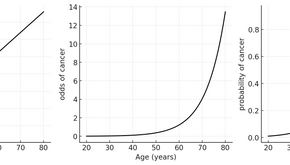
Mallet Finger: Diagnosis, Splinting, and Surgical Indications
🧠 What is Mallet Finger? Mallet finger, also known as baseball finger , is the disruption of the terminal extensor tendon at the distal...

Mallet Thumb: Pathophysiology, Diagnosis, and Management
✋ What is Mallet Thumb? Mallet thumb is the terminal extensor tendon injury of the thumb at the interphalangeal (IP) joint. It’s...

Stata Interaction Syntax: When to Use # vs ## in Clinical Models
🔍 Why This Matters Clinical models are often multifactorial : Repeated measurements (e.g., over time) Group allocations (e.g.,...

Covariate, Cofactor, or Confounder? How to Model Each in a DAG for Causal Clarity
🔍 Why This Topic Matters In clinical research, we often throw around terms like “covariates,” “cofactors,” and “confounders” as if...

Nested Case-Control Studies: Efficient Cohort Sampling for Observational Research
Introduction In observational epidemiology, efficiency often determines feasibility. While traditional cohort studies track entire...

Conditional Logistic Regression in Matched Case-Control Studies: Principles, Application, and Pitfalls
Introduction In clinical research, particularly in observational studies like case-control designs, researchers often employ matching to...

Choosing the Right Modeling Strategy: Explanatory, Exploratory, and Predictive Approaches in Clinical Research
Table: Modeling Strategies in Clinical Research Dimension Explanatory Model Exploratory Model Predictive Model Primary Purpose Test a...

Clinical Guide to the Screening and Management of Dyslipidemia (Thai Guidelines 2024)
Introduction Dyslipidemia remains a significant risk factor for cardiovascular disease (CVD), the leading cause of morbidity and...

Logistic Regression in Clinical Research: Theory, Application, and Interpretation
Introduction Logistic regression is one of the most frequently applied analytical tools in clinical epidemiology and health data science....

Understanding Odds and Odds Ratios in Clinical Epidemiology
Introduction In clinical epidemiology and biostatistics, the concept of "odds" frequently arises in the analysis of binary outcomes,...

IPTW (Inverse Probability of Treatment Weighting) Made Easy: How to Rebalance Observational Data Like a Randomized Trial
In the real world, doctors don’t flip a coin to assign treatments. So when we try to compare outcomes between treated and untreated...

From Chaos to Causal Clarity: Balancing Scores and Propensity Scores Explained Simply
Introduction: Why This Matters Imagine you're trying to compare two treatments, but your patients weren't randomized. You're worried that...

Three Tools to Estimate Causal Effects Without a Trial: Model-Based, Standardisation, and Matching
Imagine you're a clinician-researcher trying to answer a deceptively simple question: “Do apples help lower blood pressure?” You can’t...

Conditional vs. Marginal Odds Ratios: Why Your Logistic Regression May Be Lying to You
👩⚕️ The Situation You’re analyzing your study: Did Drug A reduce the risk of infection compared to Drug B? You run a logistic...

Causal Thinking in Observational Studies: Matching, Propensity Scores, and IPTW Explained
When we want to know if a treatment truly causes a better outcome—especially in observational studies—we need more than just statistics....

Outcome-Driven Regression: Choosing the Right Model Based on Y in Clinical Research
Why start with Y ? Because the distribution and scale of the outcome (not the exposure) dictate: The likelihood function behind the...

How to Order LPRC Transfusion (Also CPM) for Symptomatic Anemia in IPD Settings
In non-emergency IPD (inpatient department) settings, transfusion of Leukocyte-Poor Red Cells (LPRC) is commonly done for symptomatic...

What is Marginalisation in Clinical Statistics?
Marginalisation refers to the process of transforming effect estimates derived from specific subgroups (i.e., conditional on covariates...

Collapsibility Explained with Clinical Logic: When Crude Equals Adjusted (and When It Doesn’t)
🧩 Collapsible = “Crude ≈ Adjusted” If you don’t adjust for age/sex and then do adjust , the result doesn’t change much. 💊 Example:...

What Is Collapsibility in Clinical Statistics?
Collapsibility is a property of effect measures that determines whether the measure changes when you (statistically) adjust or don’t...








